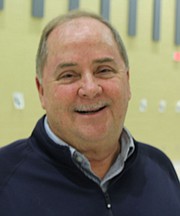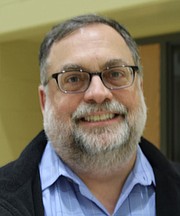Chris Herren has been drug-free and alcohol-free since Aug. 1, 2008. Photo by Fallon Forbush.
McLean — Chris Herren’s dream came true at age 22 when he was scheduled to play his first game for the Boston Celtics, his hometown team. On game day, announcers said the words that he had always wanted to hear his entire life: He was introduced as the starting point guard.
“I grew up with that dream,” he said. “I pretended I was a Celtic in my driveway.”
But he has no recollection of the game or his name being announced as he walked out of the stadium’s tunnel. He was too high on OxyContin.
Herren’s life has been spent battling addictions to alcohol, cocaine, painkillers and heroin. Now that he is sober, he tours the country as a motivational speaker with his nonprofit organization, the Herren Project.
He visited Langley High School in McLean on Wednesday, Nov. 30, to speak to an auditorium full of students, parents, coaches and teachers.
The former NBA player for the Denver Nuggets and the Boston Celtics had a clear message for parents who provide spaces for their kids to drink alcohol. He had a strong opinion about parents who think it’s OK to allow it as long as their kids are safe and don’t drive home because he grew up with parents who thought that it was OK.
Out of the 15 kids on his high school basketball team who drank in basements during parent-sanctioned house parties, seven became heroin addicts, he said.
That way of thinking fails kids miserably, he said. Instead, he urged them to question day one and know the reason their kids feel the need to drink or use drugs.
Why in the world would kids need drugs to hang out with their friends? he asked the crowd.
HIS ADDICTION started at age 14 when he started drinking his father’s beer.
“I grew up in a household where my father liked Miller Lites more than he liked coming home,” he said. “Growing up as a child, I always knew in my heart that my father’s drinking was destroying my family.”
“I remember like it was yesterday, crying at night listening to my mom and dad fight. I remember praying he would come home right from work and not stop at the bar with his friends.”
By the time he was 18 years old, he tried cocaine with college roommates as a freshman at Boston College. He attributed it to peer pressure.
“I said to myself, ‘I’ll try this drug one time and I’ll never do it again.’ … I had no idea at 18 years old when I promised myself just one time that … it would take 14 years to walk away from.”
He lost his scholarship and was expelled from college for failing drug tests. But he was given a second chance at California State University, Fresno.
By 21, he was in rehab for his cocaine addiction. After 30 days of treatment, he finished his senior season and was the 33rd pick of the NBA draft for the Denver Nuggets. He was sober for that rookie season.
By 22, he tried OxyContin. One 40-milligram pill turned into 1,600 milligrams per day, a $2,500 a month habit.
By age 28, heroin “had him hostage” and he could no longer play basketball. For the next four years, his addiction ran his world.
“I was a street junkie,” he says. “You could find me hustling heroin on street corners in my hometown, breaking into houses, bouncing checks, scrapping metal, collecting cans—whatever it took.”
By the time he was 32 years old, he could no longer afford heroin.
“I fell in love with vodka because vodka—as some of you know—is amazing at helping you forget,” he says.
But as soon as he got his hands on heroin again, it resulted in his fourth overdose and near-death experience.
Herren’s story of addiction has been captured in the book, “Basketball Junkie” and the ESPN Films documentary, “Unguarded.”
Langley High School athletic coaches heard Herren’s story first hand when they attended Herren’s presentation at Riverside High School in Lansdowne in February.
Since then, the coaches worked to raise the funds to bring him to Fairfax County.
In the end, the Fairfax County Public Schools, the Wilbert Tucker Woodson High School, McLean High School and Langley High School parent teacher student associations and the McLean High School and Langley High School athletic departments pulled together to sponsor Herren’s visit.
Fairfax County’s Story
“Drug and alcohol is an issue at the high school level,” says Langley High School Basketball Coach Mike O’Brien. “I’m afraid it’s starting at an even earlier age.”
Langley High School Football Coach Brian Lambe agrees.
“I’m going to be honest with you,” he said. “The wealthier the community, the worse the problem—by far.”
“It’s a problem that Langley and McLean is facing,” Lambe says. “Whether parents want to admit it or not, it’s a problem in the county and pretending it’s not a problem won’t fix it. Having a conversation and a dialogue will help.”
When O’Brien has suspicion that his students are struggling with substance abuse or suicidal thoughts, or if students confides in him that they are struggling with these issues, he tries to provide intervention by referring them to school counselors.
“I’m not adept with the issues, but I try to get the kids and parents involved,” he says.
He hopes Herren’s story resonates with his kids so that he can avoid the intervention altogether. “If we can get through to just one kid, it’s worth it to me.”
He also hopes students who are undergoing stressful situations and hardships will find other outlets after hearing about Herren’s painful struggles with substance abuse and addiction.
Alcohol is the most commonly used substance by Fairfax County youth, according to the 2015 Fairfax County Youth Survey of eighth, 10th and 12th grade students, which was published in the fall.
More than one-third of the students, nearly 36 percent, reported drinking alcohol at least once in their lifetime, and 16 percent reported drinking it in the month prior to the survey. Approximately 8 percent of the students reported binge drinking.
As students age, the rates of alcohol use increased, rising to over half of the 12th-grade students, nearly 57 percent, drinking alcohol at least once in their lifetime, and almost one-third, 32 percent, drinking it within the past month.
Marijuana was the second most commonly used substance by Fairfax County youth, with almost one in five, 19 percent, reporting that they have used it at least once in their lifetime, and 10 percent using it in the past month.
Rates of use also increased by grade level, rising to 36 percent of 12th-grade students reporting lifetime use, and 20 percent indicating use in the past month.
Fairfax County youth reported lower rates of use than those seen nationally for many of the investigated substances, according to the survey. Overall rates of use of alcohol, marijuana, inhalants and all forms of tobacco were lower than the national rates.
“It’s more about self-esteem and self-worth,” he said. “It’s about confidence and feeling comfortable. It’s about recognizing when your anxiety is high and your self-esteem is low. But nobody talks about this.” Herren said.
However, Fairfax County youth were slightly more likely than their peers nationally to report past month LSD, cocaine, methamphetamine and heroin use.
Alison Senold, who volunteered with the Langley High School Parent Teacher Student Association to organize the Herren event, says substance abuse among county teens is more of an issue than parents realize.
“I think families tend to look around McLean and Langley and Woodson districts and they go, ‘These are really nice neighborhoods. We don’t have a problem with drugs and alcohol. We send our kids to the best schools in the country.’ Yeah, they are the best schools in the country, but that doesn’t mean kids aren’t still confronted with those decisions around drug and alcohol use on a regular basis. And they still need the tools to make good decisions as they go through adolescence.”
Herren confirmed her theory.
“I’m going to be honest with you,” he said. “The wealthier the community, the worse the problem—by far.”
Senold, who is the parent of two high school boys, says she has ongoing conversations with her kids about the topic.
“They hear the conversations that go on and are aware of the parties that get thrown and they know what their friends are doing, and it takes a lot of talking and support as a parent to guide them through those decisions,” she says. “It’s not a one and done thing. You can’t just check the box.”
Lucy Caldwell, spokesperson for the Fairfax-Falls Church Community Services Board, a public agency that helps people with mental illness and substance use disorders, says this parental support system is what Herren was urging parents to provide.
“[Herren’s] message was targeting parents to not look the other way, to pay attention and know what’s going on with their child and that it’s not just a beer,” Caldwell says “It’s not about a beer or pot, but it’s about why, and that’s absolutely part of the issue.”
Caldwell was on site manning a resource table for the CSB during the event and was available to answer any questions about addiction and mental illness.
“Sadly, it’s not just about the beer. Many people do end up becoming addicted,” she says. “His message was very clear and very strong and sometimes that makes people uncomfortable.”
In her line of work, she has seen that most everyone with heroin or opioid dependency started by abusing marijuana or alcohol at a younger age.
“They don’t need to understand worst day, they need to understand first day,” Herren told parents in response to an audience question.
“I find it awfully sad when a young child loses the ability to be themselves 24-7,” he said. “When all of a sudden, a child needs a substance to get through the day; that’s not good. That’s sad.”
He told the crowd that the main point of his story was not just about drugs and alcohol.
“It’s more about self-esteem and self-worth,” he said. “It’s about confidence and feeling comfortable. It’s about recognizing when your anxiety is high and your self-esteem is low. But nobody talks about this.”
There were some tears in the audience as his talk stirred up painful emotions for some who have experience with the struggles of addiction.
As Herren walked off the stage, he let out a loud sigh of relief that reliving his troubled past was over.
What impression did his story have on you?






